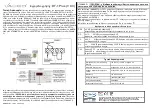
5 | GE Oil & Gas
© 2016 General Electric Company. All rights reserved.
Principles of Operation
GE’s Becker VRP-B-CH pilot and double-acting cylinder
actuator can be used in conjunction with varying valve types to
provide a complete package for stable, accurate pressure control
over a wide range of applications. The energy for control valve
operation comes from the pressure differential between the pilot
supply and discharge pressures.
The power gas channels through two adjustable orifices which
feed the top and the bottom portion of the cylinder independently.
Both sides of the actuating cylinder are under full power gas
pressure at steady state since both balanced valves are closed.
When the sensing pressure resides within the pilot deadband
region, bleed gas is virtually eliminated. The pilot therefore
operates on the design concept of a deadband within which a
non-bleeding, force-balanced state is achieved. Deadband can
be defined as the amount of change necessary in the sensing
pressure to the pilot to create a change in the output pressure to
the cylinder.
When the control pressure rises above the set point, the pilot
pistons move downward. As the top inside piston unloads the
cylinder top balance valve, the bottom piston moves away from
the balance valve plunger and maintains pressure on the bottom
of the actuator cylinder. This causes an increase in cylinder
bottom pressure and a decrease in cylinder top pressure.
The pressure differential creates the force needed to close the
valve and lessen the flow of gas. When the control pressure
returns to the setpoint, the pilot output pressures automatically
return to power gas at the new valve position.
If the control pressure falls below the setpoint, the opposite
reaction takes place.
The deadband region can be increased and decreased with the
pilot’s sensitivity adjustment drum. Increasing the deadband
increases the pilot’s error in controlling setpoint. Decreasing the
deadband reduces the error, with the tradeoff of increasing bleed
gas. Therefore, deadband is adjusted to produce an adequate
pilot response to a small change in sensing pressure, while
producing the minimum amount of bleed gas while the pilot
is in a steady state.
The variable orifices provide tuning of the stroking speed of the
actuator. Increasing the variable orifice number increases the
stroking speed. The two separate orifices allow tuning in both
directions to match the pilot response to a wide variety of valves
and operating systems.
Figure 1a - VRP-B-CH Pilot principles of operation
Figure 1b - VRP-B-CH Pilot principles of operation
Figure 1c - VRP-B-CH Pilot principles of operation









































